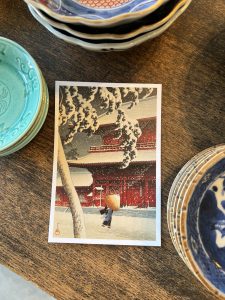ギリギリ間に合いました川瀬巴水(愛知県名古屋市千種区姫池通 骨董買取 古美術風光舎)
2023.08.01
みなさまこんにちは、スタッフYでございます。
今回もいつもの悪い癖がでてまして。美術館展覧会の開期最終日やぎりぎりを攻める癖が発動いたしました。このところ美術館などでは人員の密集を避けるため予約制のところも増えて参りましたが、予約なしのところですと、ついつい油断してしまして。気づくとぎりぎりだったりして危なかった…と、思いながら今回も最終日に訪れることになってしまいました。結構長く生きているというのにこの悪い癖はいっこうになおりません。
というわけで、駆け込みで行って参りました
「川瀬巴水 旅と郷愁の風景」展
巡回展でして、名古屋では松坂屋名古屋店内の松坂屋美術館にて昨日まででしたが、開催されておりました。
今回訪れた木版画家・川瀬巴水(1883~1957〔明治16~昭和32〕年)は、大正から昭和にかけて活躍した木版画家。近代化の波が押し寄せ、街や風景がめまぐるしく変貌していく時代に、巴水は日本の原風景を求めて全国を旅し、庶民の生活が息づく四季折々の風景を描きます。
また、巴水とともに木版画制作の道を歩んだのが、新時代の木版画「新版画」を推進した版元の渡邊庄三郎(現・渡邊木版美術画舗初代)や彫師、摺師といった職人たちの存在も大きく、四者は一体となって協業し、伝統技術を継承しながらもより高度な技術の活用を求め、新たな色彩や表現に挑み続け、「新版画」を牽引する存在として当時人気を博します。
季節や天候、時の移ろいを豊かに表現し「旅情詩人」とも呼ばれた川瀬巴水の画家としての生涯を、初期から晩年までの代表的な作品とともに紹介しており、まとめて観る機会の少ない連作(シリーズ)も含め約180点と作品も多く、今回は一気に叙情的な巴水の世界へ浸ることができました。
川瀬巴水は「旅情詩人」とよばれるように、旅先や生まれ故郷の東京を描きつづけ、風景画のジャンルで新版画をリードする存在であったようです。巴水を版画家として決定付ける歴史的な作と評価されるのが、旅に基づく初めての連作となった『旅みやげ第一集』。東北や北陸、房州、塩原などに取材した同作では、海や川といった水辺、雨や月など、巴水が生涯好んで取り上げたモチーフを多彩に描くており、当時のその地方の様子などを季節や天候、そして時間帯を、彼らの独自の画の切り取り方、色使い、技法はさすが。どの画にも、この画はこの一瞬を切り取ったのだ、というこの一枚に込めた集中力が感じ取れます。特に、雨や雪の表現は大変繊細な技巧でしして、彼らのその技法への追及がとても繊細で素晴らしいかったので、これは間近でぜひ見ていただきたいものです。
また、これとほぼ同時期に始まった『東京十二題』のように、名所だけに目を向けず、自らの関心の赴くまま、四季折々の東京の風景を独自の視点で切り取った作品も多くありました。巴水の風景画は、いわばその土地と結びついた「物語」を持たずに、一定の視座をもつひとりの人物の視点から捉えられた風景が多く、江戸時代の木版画とは少し異なるところに近代的な表現も見えてきます。これはちょっと以前鑑賞した鏑木清方作品に似ているな…時代も同じくらいだなと思っておりましたら、どうやら巴水は鏑木清方の元に弟子入りしており「巴水」の名をつけていただいたようで、驚きました。
そして、関東震災後、巴水作品を代表するのが全20図からなる『東京二十景』を発表。震災後近代都市へと復興してゆく途上にある東京を捉えた作品から、昔から変わらない風景を描いたものまでいずれの作品も人気を集めたようでして、とりわけこの連作からは、朱色の寺院に白い雪、その中を和傘の女性が歩みゆく、江戸の風情に溢れた《芝増上寺》、そして月夜に松のシルエットが浮かび上がる《馬込の月》という2つの大人気作が生まれることになりました。実は、昔この馬込近辺に住んでいたことがございまして、ちょっとびっくり致しましたが、当時ももうすでにビルや住宅街がひしめき合う都会になっておりましたが、こんな風情ある月が見える景色があったとは、見たこともない昔の風景でのどこか懐かしさも感じました。
そんな川瀬作品ですが、亡くなる74才まで40年間にわたり日本中を旅残した作品は600点以上。海外では北斎・広重と並び称され、頭文字から風景画の3H(Hokusai,hiroshige,Hasui)と呼ばれており、(新版画には他にも橋口五葉、吉田博、伊東深水など30名位の絵師がいますが、) 大人気のようで、多くの美術館やコレクターに収集されているようであります。あのスティーブ・ジョブズ氏もその一人だったようでして、今回の展示もジョブズのコレクションと同じ作品も展示されておりましたが、彼のコレクションからは、色鮮やかなわりと大きな景色を切り取った作品が好きだったことがわかります。
とまあ、180点の作品を至近距離30センチで隈なく鑑賞して出口にさしかかりましたが、入口での私とはすっかり気持ちも変わり木版画にすっかり魅了されて出口に佇んでおりました。いやいや私だけではない。きっとこの場に立つと、誰しも木版画に魅了されているに違いないと思っておりますが、機会がございましたら木版画の世界、覗いてみてください。
それでは、ごきげんよう。

Hello everyone, this is Staff Y.
This time, too, I got into my usual bad habit. I have been in the habit of attacking museum exhibitions on the last day of the opening period or at the very last minute. Recently, more and more museums require reservations in order to avoid overcrowding, but when there are no reservations, I tend to let my guard down. I was so close to visiting on the last day of the tour when I realized I was just in time…and I ended up visiting again on the last day of the tour. I have been alive for quite a long time, but this bad habit has never changed.
So, I rushed over to visit the “Kawase Tomoe Mizue: Travels and Art” exhibition.
Kawase Tomoe Sui: Landscape of Travels and Nostalgia” Exhibition
It is a traveling exhibition, and in Nagoya, it was held at Matsuzakaya Museum of Art in Matsuzakaya Nagoya until yesterday.
Kawase Boesui (1883-1957), the woodblock print artist we visited this time, was active from the Taisho to Showa periods. In an era of modernization, when towns and landscapes were undergoing rapid changes, Tomoe travelled around Japan in search of original Japanese landscapes, depicting seasonal landscapes where the lives of ordinary people still lived.
The four parties collaborated in unison, seeking to utilize more advanced techniques while continuing to carry on traditional techniques, and taking on the challenge of new colors and new expressions. The four parties collaborate as one and continue to challenge themselves to create new colors and expressions, seeking to utilize more advanced techniques while inheriting traditional techniques, and gaining popularity as the driving force behind “new prints.
The exhibition introduces the life of Tomoe Kawase, who was also called a “traveler’s poet” for his rich expression of the seasons, weather, and the transitions of time, along with his representative works from his early years to his later years. I was able to immerse myself in the lyrical world of Tomoe Sui at once.
Kawase Tomoe Sui, known as a “traveler’s poet,” continued to depict his travels and his birthplace, Tokyo, and seems to have been a leader in the new print genre of landscape painting. Tomoe’s first series of works based on his travels, “Tabi-miyage Dai-ichi” (First series of travel souvenirs), is regarded as a historic work that defined Tomoe as a printmaker. In this series, which was based on his travels in Tohoku, Hokuriku, Boshu, Shiobara, and other regions, Tomoe Sui depicted a variety of motifs that he favored throughout his life, such as the ocean, rivers and other bodies of water, rain, and the moon. In each painting, one can sense the concentration they put into this single piece, as if they were capturing this one moment in time. In particular, the rain and snow were rendered with great delicacy, and their pursuit of this technique was so delicate and wonderful that it is definitely worth seeing up close and personal.
In addition, there were many works such as “Twelve Views of Tokyo,” which started around the same time, that did not focus only on famous landmarks but also depicted the seasonal scenery of Tokyo from their own unique perspectives, following their own interests. Many of Tomoe’s landscapes are captured from the viewpoint of a single person with a certain perspective, without a “story” associated with the area, so to speak, and we can see modern expressions in his landscapes, which differ slightly from woodblock prints of the Edo period. I was thinking that these works were similar to the works of Kaburaki Kiyokata, which I had seen before…and that they were from the same period.
After the Great Kanto Earthquake, Tomoe Sui published “Twenty Views of Tokyo,” a series of 20 paintings that are representative of his work. From this series of works, two very popular works were created: “Shiba Zojoji Temple,” with its vermilion temple surrounded by white snow and a woman with a Japanese umbrella walking through the snow, which is full of the atmosphere of Edo, and “Magome no Tsuki” with the silhouette of a pine tree floating in the moonlit night. The “Moon over Magome,” in which the silhouette of a pine tree emerges in the moonlit night, are two of his most popular works. I used to live in the Magome area, and was a bit surprised to see such an elegant view of the moon, which I had never seen in the past.
Kawase traveled all over Japan for 40 years until his death at the age of 74, and left behind more than 600 works. His works are called 3H (Hokusai, Hiroshige, Hasui), which stands for landscape paintings, along with those of Hokusai and Hiroshige, and is very popular and collected by many museums and collectors (although there are about 30 other artists in Shinpanga, including Goyo Hashiguchi, Hiroshi Yoshida, and Shinsui Ito). Many museums and collectors seem to collect them. Steve Jobs was one of them, and this exhibition included some of the same works from his collection, but we can see from his collection that he liked colorful and rather large landscape cutouts.
I was standing at the exit, completely fascinated by the woodblock prints and feeling completely different from the way I felt at the entrance. No, no, no, it was not only me. I am sure that everyone who stands here must be fascinated by woodblock prints, and if you have a chance, please take a peek at the world of woodblock prints.
So, have a good day.
*******************
ご実家の整理やお片付けなどをされている方のご相談などが多くございます。
お片付けなどくれぐれもご無理のないようになさってくださいませ。
風光舎では古美術品や骨董品の他にも絵画や宝石、趣味のお品など様々なジャンルのものを買受しております。
お片付けをされていて、こういうものでもいいのかしらと迷われているものでも、どうぞお気軽にご相談下さいませ。
また風光舎は、出張買取も強化しております。ご近所はもちろん、愛知県内、岐阜県、三重県その他の県へも出張いたします。
まずは、お電話お待ちしております。
愛知県名古屋市千種区姫池通
骨董 買取【古美術 風光舎 名古屋店】
TEL052(734)8444
10:00-17:00 OPEN
#出張買取#骨董#古美術#骨董品#絵画#版画#茶道具#刀剣#彫刻


